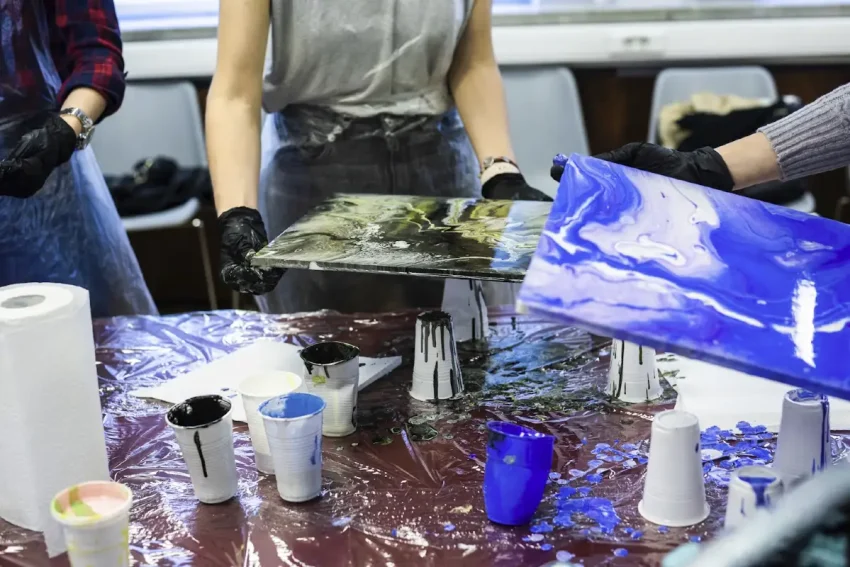How Visual Arts Therapy Became a Vital Part of Teen Mental Health Programs

Much effort has gone into evolving mental health awareness from a stigmatized topic to an essential part of health discussions. As the interconnectedness of physical, mental, and spiritual well-being was recognized, creative and alternative therapies became commonplace.
Mental health facilities for teens, in particular, are exploring new, integrative, and holistic methods for more personalized care. Moving beyond traditional talk therapy makes teens feel safe, valued, and validated.
One of the most promising approaches emerging from this belief is visual arts therapy. It’s a powerful tool that blends creative expression with psychological healing. However, it wasn’t always a clinical intervention.
This article will explore how art became a therapeutic approach and what value it brings to teen mental health recovery.
Contents
From an Optional Interest to a Formalized Practice
Artistic expression for communicating ideas and stories has been the norm for centuries. Initially, nobody thought of art from a mental healing viewpoint. The concept of art therapy was largely unknown, much less used formally.
Remnants of ancient artwork can still be found across all cultures in some form or another. Take the example of mosaics and paintings from Mesopotamia, which are still preserved in museums worldwide. Another notable example would be the sculptures and petroglyphs (rock art carvings) inside Indian caves.
From there, art proceeded to become a major part of everyday life, especially in architecture. Perhaps one of the greatest demonstrations of this is the Roman Empire. The National Geographic Society shares a striking example of how the Romans transformed basic building columns from structural to decorative.
As we enter the Renaissance period, specifically the High Renaissance (1490-1527), art seems to have reached its pinnacle of glory. Exceptional artistic achievements were seen in the persons of Leonardo da Vinci, Michelangelo, and Raphael. During this time, art had become more of a scholarly pursuit.
Fast-forward to the mid-20th century, and we see another role of art taking shape. Adrian Hill, a British artist, discovered, to his own surprise, that art played a therapeutic role in his tuberculosis recovery. It is he who coined the term art therapy in 1942. A few years from then, he also formalized his discovery into a common practice.
Art-Based Therapeutic Approaches Commonly Used Today
When we speak of art therapy in contemporary terms, it’s the use of artistic methods to treat psychological disorders. Despite becoming a part of medical science, art has not lost its creative expression. In reality, art therapy is based on the belief that creative expression can foster mental well-being.
Visual arts therapy can take on numerous forms. Polaris Teen Center considers this aspect of art therapy to be perfect for teens, as each individual can benefit from varying approaches. Let’s look at the most commonly used art-based therapeutic approaches:
Painting
Adolescence can be a period full of turmoil, as suggested by the storm and stress view. Some of the common struggles teens face include peer pressure, self-esteem issues, and anxiety/depression.
The American Art Therapy Association shares that art therapy can tackle the latter two issues, fostering self-esteem and building emotional resilience. However, it’s most effective when led by an experienced professional.
Painting is the most common form of art therapy, involving the use of mediums like watercolors, acrylics, or oil paints. Let’s see the different types of sessions a teen can participate in:
- Emotion painting where they need to use colors based on how they feel
- Self-portraits to explore their identity and self-image
- Abstract paintings that focus on releasing stress through random brushstrokes
- Collaborative paintings that promote teamwork and communication
Collaging
Collaging is another approach that involves the use of cutout images, text, or fabric to create visual compositions. The repetitive, tactile nature of this activity is calming and meditative.
An art therapist may give a theme-based prompt or simply allow the teen’s faculties creative freedom. Common activities that come under collaging include:
- Vision boards that focus on goals and aspirations
- Emotion collages where colors and images represent feelings
- Magazine identity collages, one where texts and images represent the teen’s personality and interests
- Inside/outside collages that help the teen express how they feel inside vs. how they present themselves to others
Sculpting
Sculpting is a unique art form where teens get to create three-dimensional figures using materials like clay, papier mache, and wires. Working with one’s hands to mold and shape the clay acts as a direct physical outlet for stress, anger, and anxiety.
It also restores a sense of agency and control, valuable for those dealing with emotional instability or trauma. This approach makes it easier to explore themes related to self-image and identity. Listed below are the commonly used sculpting activities:
- Clay figures that could represent the self or a feeling
- Mask making that shows the contrast between inner feelings and outer appearances
- Miniature safe space models to showcase a space the teen feels most secure in
- Problem-solving sculptures that serve as a potential solution for a visual representation challenge
Mandala Art
This form of art therapy mainly involves using pencils, markers, and micron pens. It’s the creation of circular designs that symbolize wholeness, inner harmony, and balance. This is especially conveyed through the symmetrical and intricate patterns within the circles.
Mandala art is the most beneficial for fostering emotional regulation. The structured format offers a sense of safety and containment to those who may feel disorganized or emotionally overwhelmed.
Let’s look at the different types of mandala art that teens can participate in:
- Coloring pre-drawn mandalas for relaxation
- Freeform mandala creation that encourages personal expression
- Life mandalas, where the circle can be divided into sections representing areas like family, school, etc.
- Mood mandalas that use shapes and colors to express emotions
Value Art Therapy Brings to Teen Mental Health Recovery
The visual arts therapy market is expected to generate $3.67 billion by 2030. In this vast market, over 25% of the share is taken by the mental health segment. This is no coincidence, as therapists are finding immense value in this practice.
Today, art therapy has become a necessary part of almost every mental health recovery program for adolescents. Here are possible reasons why, all of which highlight the value that art therapy brings:
- It’s an accessible and engaging intervention tailored to the developmental and emotional needs of teenagers.
- Since art is inclusive and adaptable, it is suitable for teens from various cultural and linguistic backgrounds.
- Art therapy is an evidence-based approach, as research shows its success in enhancing coping skills and reducing emotional distress.
- Most importantly, art therapy supports long-term growth. It goes beyond symptom relief and fosters resilience, empowerment, and identity development.
Studies show that there’s been a rise in mental health challenges among teens. The World Health Organisation (WHO) reveals that 1 in 7 individuals aged between 10 and 19 years experience a mental health disorder globally.
If mental health challenges are not addressed in adolescence, they extend into adulthood and impact quality of life. While approaches like cognitive behavioral therapy have been around, art therapy’s worldwide recognition has offered much hope.
Together, they can help our teens process their trauma and overcome mental health problems. It’s an uphill climb, but one that offers more than temporary relief, paving the way to long-term health and resilience.



